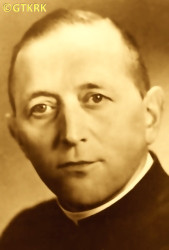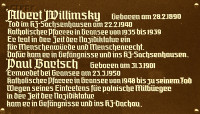Roman Catholic
St Sigismund parish
05-507 Słomczyn
85 Wiślana Str.
Konstancin deanery
Warsaw archdiocese, Poland
full list:
displayClick to display full list

searchClick to search full list by categories
wyświetlKliknij by wyświetlić pełną listę po polsku

szukajKliknij by przeszukać listę wg kategorii po polsku

Martyrology of the clergy — Poland
XX century (1914 – 1989)
personal data
surname
BARTSCH
forename(s)
Anthony Paul (pl. Antoni Paweł)
function
diocesan priest
creed
Latin (Roman Catholic) Church RCmore on
en.wikipedia.org
[access: 2014.09.21]
diocese / province
Berlin diocesemore on
en.wikipedia.org
[access: 2013.12.04]
Wrocław diocesemore on
en.wikipedia.org
[access: 2013.05.19]
nationality
German
date and place
of death
23.03.1950

Granseetoday: Oberhavel dist., Brandenburg state, Germany
more on
en.wikipedia.org
[access: 2022.08.05]
alt. dates and places
of death
24.03.1950
details of death
During World War II, started by German and Russian invasion of Poland in 09.1939, ministered among Poles slaving as forced labourers in Germany.
Because of that persecuted by the German political police Gestapo.
Few times apprehended and interrogated, among others in 01.1941.
Finally in 05.1943 arrested.
Held in Szczecin prison and then in local transit camp.
On 09.05.1943 transported to KL Dachau concentration camp.
Liberated in 04.1945 by the American forces (according to other sources released on 04.04.1945 — Americans liberated KL Dachau on 29.04.1945).
Returned to his diocese in 1947 (for two years ministered in Augsburg diocese), then already, after the end of military hostilities of the World War II, under Russian occupation.
There murdered by unknown perpetrators — during a robbery when returning from a pastoral visit in Fürstenberg village, c. 25 km from his parish seat.
prisoner camp's numbers
49612Click to display source page (KL DachauClick to display the description)
cause of death
murder
perpetrators
Germans
sites and events
KL DachauClick to display the description, Slave labour in GermanyClick to display the description, Ribbentrop‐MolotovClick to display the description, Pius XI's encyclicalsClick to display the description
date and place
of birth
31.03.1901

Borek Wielkopolskitoday: Borek Wielkopolski gm., Gostyń pov., Greater Poland voiv., Poland
more on
en.wikipedia.org
[access: 2021.05.06]
presbyter (holy orders)
ordination
15.02.1925

Wrocławtoday: Wrocław city pov., Lower Silesia voiv., Poland
more on
en.wikipedia.org
[access: 2021.04.02]
positions held
1948 – 1950
parish priest — Granseetoday: Oberhavel dist., Brandenburg state, Germany
more on
en.wikipedia.org
[access: 2022.08.05] ⋄ RC parish
1947 – 1948
rector — Petershagentoday: Minden‐Lübbecke dist., Detmold reg., North Rhine‐Westphalia state, Germany
more on
en.wikipedia.org
[access: 2022.07.16] ⋄ St Hubert RC church
from 1934
curatus/rector/expositus — Kamień Pomorskitoday: Kamień Krajeński, Kamień Krajeński gm., Sępólno Krajeńskie pov., Pomerania voiv., Poland
more on
en.wikipedia.org
[access: 2021.09.02] ⋄ Blessed Virgin Mary and St Peter and St Paul the Apostles RC church
vicar — Berlin‐Charlottenburglocality in Berlin, Charlottenburg‐Wilmersdorf borough
today: Berlin state, Germany
more on
en.wikipedia.org
[access: 2022.01.07] ⋄ Assumption of the Blessed Virgin Mary RC parish
vicar — Frankfurt an der Odertoday: Frankfurt am Main urban dist., Brandenburg state, Germany
more on
en.wikipedia.org
[access: 2020.11.13] ⋄ Holy Cross RC parish
vicar — Berlin‐Lichtenberglocality in Berlin, Lichtenberg borough
today: Berlin state, Germany
more on
en.wikipedia.org
[access: 2022.01.07] ⋄ St Maurice RC parish
till 1925
student — Wrocławtoday: Wrocław city pov., Lower Silesia voiv., Poland
more on
en.wikipedia.org
[access: 2021.04.02] ⋄ philosophy and theology, Department of Catholic Theology, University of Wrocław [i.e. University of Wrocław (since 1945) / Frederic Wilhelm University of Silesia (1911‐1945) / Royal University i.e. Breslau Academy (1816‐1911)]
others related
in death
WILLIMSKYClick to display biography Albert
sites and events
descriptions
KL Dachau: KL Dachau in German Bavaria, set up in 1933, became the main German Germ. Konzentrationslager (Eng. concentration camp) KL for Catholic priests and religious during World War II: On c. 09.11.1940, Reichsführer‐SS Heinrich Himmler, head of the SS, Gestapo and German police, as a result of the Vatican's intervention, decided to transfer all clergymen detained in various concentration camps to KL Dachau camp. The first major transports took place on 08.12.1940. In KL Dachau Germans held approx. 3,000 priests, including 1,800 Poles. The priests were forced to slave labor in the Germ. „Die Plantage” — the largest herb garden in Europe, managed by the genocidal SS, consisting of many greenhouses, laboratory buildings and arable land, where experiments with new natural medicines were conducted — for many hours, without breaks, without protective clothing, no food. They slaved in construction, e.g. of camp's crematorium. In the barracks ruled hunger, freezing cold in the winter and suffocating heat during the summer, especially acute in 1941‐1942. Prisoners suffered from bouts of illnesses, including tuberculosis. Many were victims of murderous „medical experiments” — in 11.1942 c. 20 were given phlegmon injections; in 07.1942 to 05.1944 c. 120 were used by for malaria experiments. More than 750 Polish clerics where murdered by the Germans, some brought to TA Hartheim euthanasia centre set up in Schloss Hartheim in Austria and murdered in gas chambers. At its peak KL Dachau concentration camps’ system had nearly 100 slave labour sub‐camps located throughout southern Germany and Austria. There were c. 32,000 documented deaths at the camp, and thousands perished without a trace. C. 10,000 of the 30,000 inmates were found sick at the time of liberation, on 29.04.1945, by the USA troops… (more on: www.kz-gedenkstaette-dachau.deClick to attempt to display webpage
[access: 2013.08.10], en.wikipedia.orgClick to attempt to display webpage
[access: 2016.05.30])
Slave labour in Germany: During World War II Germans forced c. 15 million people to do a slave forced labour in Germany and in the territories occupied by Germany. In General Governorate the obligation to work included Poles from 14 to 60 years old. On the Polish territories occupied and incorporated into Germany proper obligation was forced upon children as young as 12 years old — for instance in Warthegau (Eng. Greater Poland). (more on: en.wikipedia.orgClick to attempt to display webpage
[access: 2017.11.07])
Ribbentrop‐Molotov: Genocidal Russian‐German alliance pact between Russian leader Joseph Stalin and German leader Adolf Hitler signed on 23.08.1939 in Moscow by respective foreign ministers, Mr. Vyacheslav Molotov for Russia and Joachim von Ribbentrop for Germany. The pact sanctioned and was the direct cause of joint Russian and German invasion of Poland and the outbreak of the World War II in 09.1939. In a political sense, the pact was an attempt to restore the status quo ante before 1914, with one exception, namely the „commercial” exchange of the so‐called „Kingdom of Poland”, which in 1914 was part of the Russian Empire, fore Eastern Galicia (today's western Ukraine), in 1914 belonging to the Austro‐Hungarian Empire. Galicia, including Lviv, was to be taken over by the Russians, the „Kingdom of Poland” — under the name of the General Governorate — Germany. The resultant „war was one of the greatest calamities and dramas of humanity in history, for two atheistic and anti‐Christian ideologies — national and international socialism — rejected God and His fifth Decalogue commandment: Thou shall not kill!” (Abp Stanislav Gądecki, 01.09.2019). The decisions taken — backed up by the betrayal of the formal allies of Poland, France and Germany, which on 12.09.1939, at a joint conference in Abbeville, decided not to provide aid to attacked Poland and not to take military action against Germany (a clear breach of treaty obligations with Poland) — were on 28.09.1939 slightly altered and made more precise when a treaty on „German‐Russian boundaries and friendship” was agreed by the same murderous signatories. One of its findings was establishment of spheres of influence in Central and Eastern Europe and in consequence IV partition of Poland. In one of its secret annexes agreed, that: „the Signatories will not tolerate on its respective territories any Polish propaganda that affects the territory of the other Side. On their respective territories they will suppress all such propaganda and inform each other of the measures taken to accomplish it”. The agreements resulted in a series of meeting between two genocidal organization representing both sides — German Gestapo and Russian NKVD when coordination of efforts to exterminate Polish intelligentsia and Polish leading classes (in Germany called «Intelligenzaktion», in Russia took the form of Katyń massacres) where discussed. Resulted in deaths of hundreds of thousands of Polish intelligentsia, including thousands of priests presented here, and tens of millions of ordinary people,. The results of this Russian‐German pact lasted till 1989 and are still in evidence even today. (more on: en.wikipedia.orgClick to attempt to display webpage
[access: 2015.09.30])
Pius XI's encyclicals: Facing the creation of two totalitarian systems in Europe, which seemed to compete with each other, though there were more similarities than contradictions between them, Pope Pius XI issued in 03.1937 (within 5 days) two encyclicals. In the „Mit brennender Sorge” (Eng. „With Burning Concern”) published on 14.03.1938, condemned the national socialism prevailing in Germany. The Pope wrote: „Whoever, following the old Germanic‐pre‐Christian beliefs, puts various impersonal fate in the place of a personal God, denies the wisdom of God and Providence […], whoever exalts earthly values: race or nation, or state, or state system, representatives of state power or other fundamental values of human society, […] and makes them the highest standard of all values, including religious ones, and idolizes them, this one […] is far from true faith in God and from a worldview corresponding to such faith”. On 19.03.1937, published „Divini Redemptoris” (Eng. „Divine Redeemer”), in which criticized Russian communism, dialectical materialism and the class struggle theory. The Pope wrote: „Communism deprives man of freedom, and therefore the spiritual basis of all life norms. It deprives the human person of all his dignity and any moral support with which he could resist the onslaught of blind passions […] This is the new gospel that Bolshevik and godless communism preaches as a message of salvation and redemption of humanity”… Pius XI demanded that the established human law be subjected to the natural law of God , recommended the implementation of the ideal of a Christian state and society, and called on Catholics to resist. Two years later, National Socialist Germany and Communist Russia came together and started World War II. (more on: www.vatican.vaClick to attempt to display webpage
[access: 2023.05.28], www.vatican.vaClick to attempt to display webpage
[access: 2023.05.28])
sources
personal:
pl.wikipedia.orgClick to attempt to display webpage
[access: 2020.05.30], www.tag-des-herrn.deClick to attempt to display webpage
[access: 2020.05.30]
original images:
www.tag-des-herrn.deClick to attempt to display webpage
[access: 2020.05.30], commons.wikimedia.orgClick to attempt to display webpage
[access: 2013.12.04]
LETTER to CUSTODIAN/ADMINISTRATOR
If you have an Email client on your communicator/computer — such as Mozilla Thunderbird, Windows Mail or Microsoft Outlook, described at WikipediaPatrz:
en.wikipedia.org, among others — try the link below, please:
LETTER to CUSTODIAN/ADMINISTRATORClick and try to call your own Email client
If however you do not run such a client or the above link is not active please send an email to the Custodian/Administrator using your account — in your customary email/correspondence engine — at the following address:

giving the following as the subject:
MARTYROLOGY: BARTSCH Anthony Paul
To return to the biography press below:
 Click to return to biography
Click to return to biography









